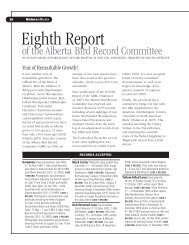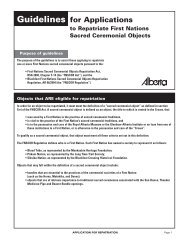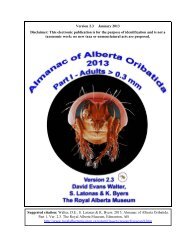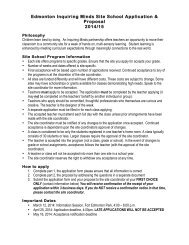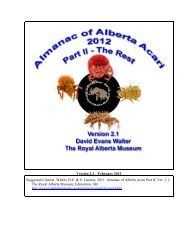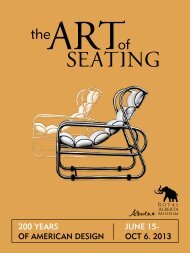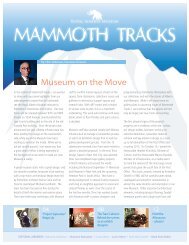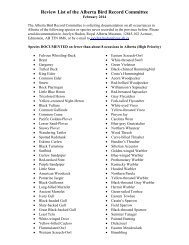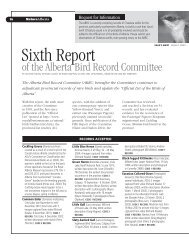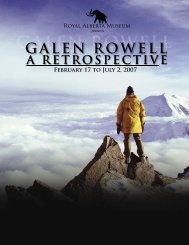Sahl kit pdf.indd - Royal Alberta Museum
Sahl kit pdf.indd - Royal Alberta Museum
Sahl kit pdf.indd - Royal Alberta Museum
You also want an ePaper? Increase the reach of your titles
YUMPU automatically turns print PDFs into web optimized ePapers that Google loves.
may 7,,2005-September 18,,2005
MUSEUM PRICES<br />
: Annual Mammoth Pass:<br />
(Unlimited Admission<br />
plus benefits)<br />
Adult (18-64 years) $10 $35<br />
Senior (65 and over) $8 $30<br />
Student (with ID) $7 $30<br />
Youth (7-17) $5 $20<br />
Family (Two adults and children 7-17) $28 $70<br />
Grandparent<br />
(Two grandparents and children 7-17) NA $60<br />
Half Price 9 am - 11 am<br />
Saturdays and Sundays<br />
MUSEUM HOURS:<br />
Open Daily:<br />
The <strong>Museum</strong> will be closed<br />
December 24 & 25<br />
9 am to 5 pm<br />
The <strong>Museum</strong> Shop<br />
In celebration of <strong>Alberta</strong>’s 100th<br />
birthday, The <strong>Museum</strong> Shop will feature<br />
some unique gifts and keepsakes<br />
commemorating <strong>Alberta</strong>’s Centennial.<br />
You’ll find books, jewellery, games,<br />
clothes, toys – something for everyone<br />
in the family! Try our exclusive new<br />
<strong>Museum</strong> Tea, and lose yourself in the<br />
new Syncrude Gallery of Aboriginal<br />
Culture book.<br />
Look for the new SALH history book:<br />
“Century of Service: The History of The<br />
South <strong>Alberta</strong> Light Horse”
WORDS FROM<br />
DR. BRUCE MCGILLIVRAY<br />
It is not often that you<br />
get a chance to host a<br />
birthday celebration for two<br />
Centennarians. With the<br />
exhibition, Hoof Prints to Tank<br />
Tracks, we are celebrating both<br />
<strong>Alberta</strong>’s Centennial and 100<br />
years of the South <strong>Alberta</strong> Light<br />
Horse Regiment.<br />
This exhibition would not have<br />
been possible without the<br />
financial support of The South<br />
<strong>Alberta</strong> Light Horse Regiment<br />
Foundation and the hard work of<br />
two teams. I would like to thank,<br />
from the SALH:<br />
Honorary Colonel S. A. Milner;<br />
Lieutenant Colonel Thomas E.<br />
Putt, CD; Captain Colin Michaud;<br />
Master Warrant Officer Jim<br />
Ogston, CD; and Susan Angus,<br />
and from The Provincial <strong>Museum</strong><br />
of <strong>Alberta</strong> Hannah Aaron, Sean<br />
Moir, Paul Beier, Steve Fisher,<br />
Julie Calderbank and David<br />
Parama.<br />
It is my hope that through this<br />
exhibition, <strong>Alberta</strong>ns will gain a<br />
deeper appreciation of the role<br />
the South <strong>Alberta</strong> Light Horse has<br />
played, and continues to play, in<br />
shaping our <strong>Alberta</strong>.<br />
W. Bruce McGillivray, Ph.D.<br />
Director<br />
The Provincial <strong>Museum</strong> of <strong>Alberta</strong><br />
On the Centennial of the Province<br />
of <strong>Alberta</strong> and the South <strong>Alberta</strong><br />
Light Horse, we are delighted to<br />
be part of this important occasion<br />
in presenting Hoof Prints to<br />
Tank Tracks. This history of<br />
<strong>Alberta</strong> as it has unfolded is seen<br />
through the eyes of those who<br />
were prepared to sacrifice their<br />
lives for their fellow <strong>Alberta</strong>ns<br />
and Canadians in the wars of the<br />
20th century. The story of the<br />
South <strong>Alberta</strong> Light Horse actually<br />
begins in the days before <strong>Alberta</strong><br />
became a province, when the<br />
volunteers of the Rocky Mountain<br />
Rangers stood ready to protect<br />
their communities from the threat<br />
of a major uprising.<br />
Over the last half century, through<br />
a series of amalgamations,<br />
the South <strong>Alberta</strong> Light<br />
Horse has emerged as the<br />
proud descendant of many<br />
distinguished predecessor units.<br />
As with all Militia regiments<br />
across Canada, the Light Horse<br />
and its predecessors have fought<br />
two different types of battles<br />
– they defended Canada during<br />
times of international conflict and<br />
they struggled to survive in the<br />
SOUTH ALBERTA LIGHT HORSE EXHIBITION<br />
Words from<br />
Honorary Colonel S. A. Milner, OC, AOE, CD, LL.D. and Honorary Lieutenant-Colonel J. D. Watson, FCA<br />
cost-cutting times of peace. It<br />
is perhaps in this way, more than<br />
any other, that the Light Horse’s<br />
history of struggle corresponds<br />
with the history of the province,<br />
which provided most of the<br />
soldiers who served in its ranks.<br />
We need the Militia. It is essential<br />
to the effective functioning of a<br />
democracy as is a police force,<br />
fire department or emergency<br />
services. The fundamental<br />
principal of the Militia today<br />
mirrors that of the Militia of 1905<br />
- it is built upon a dedicated<br />
population of citizen soldiers who<br />
are prepared to sacrifice much in<br />
the service to their country and<br />
Queen.<br />
The soldiers of the South <strong>Alberta</strong><br />
Light Horse are pleased that you<br />
have taken the time to review<br />
their history. They have been<br />
inspired by the dedication of the<br />
women and men who went before<br />
them, and their legacy has been a<br />
source of pride to the members of<br />
the Regiment. We hope it will be<br />
an inspiration to you to serve your<br />
community.<br />
Honorary Colonel S. A. Milner,<br />
OC, AOE, CD, LL.D.<br />
Edmonton<br />
Honorary Lieutenant-Colonel J.D.<br />
Watson, FCA<br />
Calgary<br />
Words from<br />
Lieutenant-Colonel Thomas E. Putt, CD<br />
It is my privilege to command<br />
the South <strong>Alberta</strong> Light Horse<br />
regiment during its Centennial<br />
year of 2005.<br />
To mark this important milestone,<br />
The Light Horse and The South<br />
<strong>Alberta</strong> Light Horse Regiment<br />
Foundation have partnered with<br />
The Provincial <strong>Museum</strong> of <strong>Alberta</strong><br />
to develop this exciting exhibition,<br />
Hoof Prints to Tank Tracks.<br />
The South <strong>Alberta</strong> Light Horse<br />
is the senior and truly provincial<br />
militia in <strong>Alberta</strong>. In its century<br />
of existence, it has forged<br />
historical links with almost every<br />
community in <strong>Alberta</strong>. The Light<br />
Horse is a community of men and<br />
women in which the strengths<br />
of the individuals are directed<br />
toward a common good and the<br />
weaknesses buttressed by a<br />
common goal. Indeed, it is why<br />
so many of us volunteer to serve<br />
our nation.<br />
I would like to say that I feel that<br />
the Hoof Prints to Tank Tracks<br />
exhibition has captured the story<br />
and the spirit of the Light Horse<br />
and of its home province very<br />
well. With such a splendid past<br />
behind us, the South <strong>Alberta</strong> Light<br />
Horse can move with confidence<br />
into its second century. It will<br />
continue to serve – according to<br />
its motto, Semper Alacer, “Always<br />
Alert” – both the Dominion of<br />
Canada and the Province of<br />
<strong>Alberta</strong>.<br />
Lieutenant-Colonel Thomas E.<br />
Putt, CD<br />
Commanding Officer<br />
The South <strong>Alberta</strong> Light Horse
EXHIBITION ELEMENTS<br />
The South <strong>Alberta</strong> Light Horse is one of<br />
the last of the Light Horse regiments in the<br />
Commonwealth. Members of the Regiment<br />
continue to answer the call of duty by serving<br />
on NATO and United Nations missions<br />
abroad and by aiding local authorities during<br />
emergencies within Canada.<br />
The exhibition is divided into six chronologically<br />
distinct units. Each unit explores four<br />
recurrent themes and their relationship with the<br />
development of the Province over the last 100<br />
years. Visitors will experience:<br />
•the voices and personal stories from past and<br />
Highlights of the gallery include:<br />
• a reconditioned Second World War-era<br />
Halftrack (weighing in at more than 9 tonnes,<br />
this is the heaviest individual artifact ever<br />
displayed in the <strong>Museum</strong>)<br />
• the guidon – the unit’s most sacred and<br />
I hope that this exhibition, not only of<br />
the South <strong>Alberta</strong> Light Horse, but its<br />
present members of the Regiment;<br />
•thematic displays exploring the Regiment’s role<br />
during the First and Second World Wars;<br />
cherished symbol<br />
• film footage dating from the Second World<br />
War, including training techniques and a one-<br />
predecessor units, conveys to the citizens •a chronology of significant achievements<br />
minute segment relating to the surrender of<br />
of <strong>Alberta</strong> how its “Citizen Soldiers” have<br />
contributed to their communities, the<br />
province and country in war and peace.<br />
during times of war and peace;<br />
•examples of the technology and tactics<br />
employed by the Regiment; and<br />
•an examination of the daily life of active-duty<br />
thousands of German troops at St-Lambert-sur-<br />
Dives, France, and<br />
• a 2005 G-Wagon, loaded with<br />
communications and surveillance equipment, of<br />
– Master Warrant Officer Jim Ogston, co-curator<br />
soldiers, including their recreational pursuits.<br />
the type currently being used in Afghanistan by<br />
Canadian soldiers.<br />
PROGRAMMING EVENTS<br />
Official Opening<br />
Saturday, May 7<br />
between 1 pm and 4 pm<br />
Daily Activities<br />
Join our special VIP guests on the official<br />
opening day for activities including a military<br />
parade, camouflage face painting, a spit shine<br />
demonstration and all of the activities listed below.<br />
Family Activity Book<br />
Earn your stripes with an activity book that will<br />
assist you with exploring 100 years of The South<br />
<strong>Alberta</strong> Light Horse – it’s a great take-home<br />
souvenir of your visit!<br />
Collect a Cap Badge Button<br />
Grab a badge (identifying rank and regiment) then<br />
explore the gallery to learn about its meaning<br />
and significance.<br />
Morale by Mail<br />
Write a postcard to a Canadian Armed Forces<br />
member overseas and the <strong>Museum</strong> will send it<br />
on your behalf.<br />
Origami<br />
Reflect on the meaning of peace while you fold<br />
an origami crane. Your crane will be added to<br />
the display of (hopefully) 1,000 cranes to fulfil a<br />
wish for peace.
ISTORY OF THE SALH<br />
Early History<br />
The South <strong>Alberta</strong> Light Horse<br />
(SALH) pre-dates the founding of<br />
the Province by two months and<br />
is one of the oldest militia units<br />
in Western Canada, tracing its<br />
official lineage to the formation of<br />
the 15th Light Horse in July 1905,<br />
two months prior to the founding<br />
of the province of <strong>Alberta</strong>.<br />
Through a complicated series of<br />
amalgamations and designations<br />
the SALH now perpetuates more<br />
than 25 units, including the<br />
Rocky Mountain Rangers of Fort<br />
Macleod, who served during the<br />
Northwest Rebellion of 1885. The<br />
current Regiment was formed in<br />
Calgary in 1954.<br />
First World War<br />
Several of the units perpetuated<br />
by the SALH participated in<br />
the First World War as part of<br />
the Canadian Expeditionary<br />
Force (CEF): the 12th and 13th<br />
Regiments of the Canadian<br />
Mounted Rifles, 15th Light Horse,<br />
the 19th <strong>Alberta</strong> Dragoons, and<br />
the 31st, 113th, 175th and the<br />
187th Overseas Battalions CEF.<br />
The 31st Battalion, CEF<br />
participated in the first tank<br />
attack in history at the Battle of<br />
Coucelette on September 15,<br />
1916; members from the 19th<br />
<strong>Alberta</strong> Dragoons and 15th Light<br />
Horse took part in the last cavalry<br />
charge in Canadian history at the<br />
Battle of Iwuy on October 10,<br />
1918.<br />
Despite its cavalry beginnings, the Regiment<br />
fought in the war predominately as infantry<br />
and arrived back in Canada at the war’s end<br />
with 19 Battle Honours to its credit, including<br />
such notable actions as Vimy and Ypres. After<br />
the War, the Vimy Memorial was unveiled by<br />
King Edward VIII. During his speech, he spoke<br />
to the great sacrifice the nation made and the<br />
accomplishments of the men who won the war<br />
for the Empire.<br />
Interwar era (1920s-1930s)<br />
The period between wars saw the re-emergence<br />
of the15th Light Horse and the 19th <strong>Alberta</strong><br />
Dragoons, as well as the establishment of<br />
the South <strong>Alberta</strong> Regiment. The former were<br />
cavalry units based in Calgary and Edmonton;<br />
the latter was an infantry regiment based in<br />
Medicine Hat.<br />
Second World War<br />
The 15th Light Horse and the 19th <strong>Alberta</strong><br />
Dragoons remained in Canada during the<br />
Second World War, aiding the effort by recruiting<br />
members for active service overseas. The South<br />
<strong>Alberta</strong> Regiment (SAR) was made part of the<br />
Canadian Active Service Force (CASF) in 1940.<br />
The SAR was converted to an armoured unit in<br />
January 1942 and moved to England in August<br />
of that same year.<br />
In 1943, the SAR was re-designated the 29th<br />
Armoured Reconnaissance Regiment (SAR),<br />
chosen by Major General Worthington, head<br />
of the <strong>Royal</strong> Canadian Armoured Corps, to be<br />
his reconnaissance team because he wanted<br />
“keen-eyed prairie men” as his scouts. In short,<br />
it was selected to be the eyes and ears of the<br />
<strong>Royal</strong> Canadian Armoured Corps.<br />
The Regiment’s participation in the Second<br />
World War, from which it emerged with 15 more<br />
Battle Honours, can be attributed mainly to the<br />
action of the 29th Armoured Reconnaissance<br />
Regiment. The men of the 29th saw action in<br />
France, Belgium, the Netherlands and Germany.<br />
Of particular note, Major David Currie was<br />
awarded the Victoria Cross for his actions<br />
during the closing days and hours of the battle<br />
of the Falaise Gap.<br />
Post Second World War<br />
The year 1954 saw the emergence of the South<br />
<strong>Alberta</strong> Light Horse (29th Armoured Regiment);<br />
the result of a merger of two Calgary-based<br />
<strong>Royal</strong> Canadian Artillery units, the 68th Light<br />
Anti-Aircraft and 41st Anti-Tank regiments, and<br />
the South <strong>Alberta</strong> Regiment (militia infantry) of<br />
Medicine Hat. The newly formed South <strong>Alberta</strong><br />
Light Horse was established as an armoured<br />
unit. It moved its headquarters to Medicine Hat<br />
in 1960. With the loss of its tanks in 1968 the<br />
unit was once again re-tasked as an armoured<br />
reconnaissance regiment.<br />
‘B’ Squadron, Edmonton, was established in<br />
1978, with training undertaken at Griesbach<br />
Barracks. During the 1980s, new vehicles called<br />
Cougar AVGPs (Armoured Vehicle General<br />
Purpose) were acquired, and the unit was once<br />
again re-rolled as an armoured regiment.<br />
2004 and Beyond<br />
Today, Regimental Headquarters, Headquarters<br />
and ‘B’ Squadrons are situated in Edmonton,<br />
and ‘A’ Squadron remains in Medicine Hat.<br />
With the advent of the Land Force Reserve<br />
Restructuring project, the South <strong>Alberta</strong> Light<br />
Horse returned to its reconnaissance roots on<br />
September 1st, 2004.<br />
These excerpts were taken from the South<br />
<strong>Alberta</strong> Light Horse’s website. For further<br />
information on their history, please visit: “http://<br />
salh.net/index.php” http://salh.net/index.php
ABOUT THE CURATORS<br />
Jim Ogston<br />
Master Warrant Officer<br />
As the founder and curator, of the South <strong>Alberta</strong><br />
Light Horse Regimental <strong>Museum</strong> in Medicine<br />
Hat, I have been active in the preservation and<br />
presentation of the history of the Regiment for<br />
the past 10 years. As this is our 100th birthday,<br />
it was with great honour that I was asked by the<br />
Commanding Officer to work with Sean Moir<br />
in creating the exhibition, Hoof Prints to Tank<br />
Tracks at The Provincial <strong>Museum</strong> of <strong>Alberta</strong>.<br />
Major Sorensen’s quote “This Is A Fine<br />
Regiment, You Can Make It The Finest” rings as<br />
true today as it did forty-odd years ago when<br />
he first uttered these words. I hope visitors<br />
will concur that the members of the The South<br />
<strong>Alberta</strong> Light Horse have much to be proud of,<br />
and that this display conveys that fact.<br />
Sean Moir<br />
Curator of Military and Political History<br />
Sean received his MA and MLIS degrees from<br />
the University of <strong>Alberta</strong>. Sean began working<br />
for heritage-related facilities and programs in<br />
1987. Between 1997 and 2004, Sean served<br />
as Curator of Documentary Collections at the<br />
Reynolds-<strong>Alberta</strong> <strong>Museum</strong>. Publications include<br />
Perilous Journeys: Early Motoring in <strong>Alberta</strong><br />
(1989), and ‘The friendly invasion’: the American<br />
presence in Edmonton (1942-1945), and For<br />
King and Country: <strong>Alberta</strong> in the Second World<br />
War (1995). Sean has been on staff at The<br />
Provincial <strong>Museum</strong> of <strong>Alberta</strong> since May 2004.<br />
Q & A<br />
with Sean Moir,<br />
Curator of Military and Government History<br />
1. Describe your responsibilities as Curator of the<br />
Military and Political History Program.<br />
The role of the Curator of Military and Political<br />
History at The Provincial <strong>Museum</strong> of <strong>Alberta</strong><br />
is to collect, care for and interpret the objects<br />
pertinent to the Program’s mandate. We collect<br />
objects representative of the functions of the<br />
Canadian military in <strong>Alberta</strong>, and to lesser<br />
degrees, throughout the rest of Canada and<br />
the world. We also collect objects relating<br />
to military forces from other countries. The<br />
Program also acquires objects representative of<br />
government functions and programs, namely at<br />
the provincial level.<br />
Other tasks and responsibilities include fielding<br />
public inquiries, developing exhibits and<br />
publications and building relationships and<br />
partnerships with relevant organizations and<br />
museums.<br />
2. What areas are encompassed in the Program’s<br />
collections?<br />
The collection is comprised of military objects<br />
representative of <strong>Alberta</strong>-based units, as well<br />
as others from across Canada, and other<br />
countries. We also have objects representative<br />
of government services and programs.<br />
Examples are police uniforms, judges’ robes<br />
and political campaign buttons.<br />
We have a large collection of firearms (nonrestricted,<br />
restricted and prohibited): rifles,<br />
handguns, semi-automatic and automatic<br />
firearms. The <strong>Museum</strong> also has a significant<br />
numismatics collection of Canadian and<br />
international tokens, coins, crowns and<br />
currency.<br />
3. What has been your role in the creation of the<br />
SALH exhibition?<br />
My role is that of Co-curator; Jim Ogston of<br />
The South <strong>Alberta</strong> Light Horse Regiment is<br />
the other curator of the exhibition. We, along<br />
with input from many others, came up with a<br />
basic story line, researched the topic, wrote the<br />
text, and selected the artifacts, images, and<br />
audiovisual components. Upon the exhibition’s<br />
opening, I will have dedicated about five months<br />
to the project – that is not a lot of time for an<br />
exhibition that is almost 5,000 square feet. As<br />
Jim is a serving member, it made sense for him<br />
to tackle the more modern and current eras;<br />
I was responsible for the earlier periods up to<br />
the end of the Second World War. We shared<br />
the work load with respect to selecting images,<br />
audiovisual components and artifacts.<br />
4. In your opinion, why is this exhibition<br />
important? What do you hope <strong>Alberta</strong>ns will take<br />
away after a visit to the exhibition?<br />
In light of events since the 1991 war with<br />
Iraq, and the subsequent military actions the<br />
United States has undertaken in a number<br />
of mid-eastern countries, we have become<br />
accustomed to viewing the actions of the<br />
American military on TV. At the same time,<br />
we have also been dealt a fairly regular diet<br />
of stories pertaining to the lack of ability, and<br />
failings of, the Canadian Military. I think it is very<br />
important for Canadians, especially younger<br />
people, to understand something of the role<br />
the Canadian military has played at home and<br />
abroad, past and present. That contribution is<br />
important, significant and impressive!<br />
For example, by the end of the Second World<br />
War, Canada had the fourth largest navy in the<br />
world – a disproportionately high ranking for<br />
a nation of about 15 million people. Why was<br />
this? Canada played a huge role in the very<br />
dangerous role of convoy escort work between<br />
North America and Britain. Many Canadian<br />
sailors and merchant mariners died on account<br />
of the German submarines present throughout<br />
Atlantic waters.<br />
Which nation’s troops were given the task of<br />
clearing the vital coastal regions of North West<br />
Europe during the Second World War, as the<br />
allies marched north and east into Germany?<br />
Canadians. Who gained the heights of Vimy<br />
Ridge, a key strategic point for the allied effort<br />
during the 1st World War? Again, Canadians.<br />
Today, which nation’s troops are universally<br />
looked upon as being fair-minded and<br />
professional? Canada’s.<br />
Our contributions of personnel, equipment and<br />
monetary support have always been generous,<br />
given the overall population and wealth of our<br />
nation, and this is true of the role The South<br />
<strong>Alberta</strong> Light Horse Regiment has played over<br />
the course of the last 100 years.<br />
About The Provincial <strong>Museum</strong>’s Military and<br />
Political History Program<br />
Whether it’s federal, provincial or municipal,<br />
<strong>Alberta</strong>’s political history and military<br />
involvement—with a tradition of service and<br />
sacrifice—are important facets of our culture.<br />
The Military and Political History Program<br />
interprets the important stories of law, order<br />
and moral duty during the last 250 years in<br />
<strong>Alberta</strong>. The Program’s collection contains<br />
approximately 40,000 historical artifacts and<br />
documents, from the first provincial Speaker’s<br />
chair to impressive uniforms and rare coins. The<br />
Program also maintains an impressive collection<br />
of handcrafted 19th century firearms.
The Guidon<br />
A moth-eaten rag on a worm-eaten pole<br />
It does not look likely, to stir a man’s soul<br />
Tis the deeds that were done neath the moth-eaten rag<br />
When the pole was a staff and the rag was a flag<br />
Sir Edward Hamley<br />
A guidon is a flag or type of colour particular to a<br />
cavalry regiment. Colours, in turn, are memorials that<br />
commemorate a regiment’s deeds and extol its spirit.<br />
Regimental colours are the most treasured symbol.<br />
Traditionally, they were the rallying point on the<br />
battlefield and bore a regiment’s battle honours. To<br />
capture an opponent’s colours was a great honour.<br />
Conversely, to lose one’s colours in battle was the<br />
ultimate disgrace.<br />
Upon presentation to a regiment or when being<br />
retired, colours are blessed by members of the clergy.<br />
Canadian military units have not carried colours into<br />
battle since the time of Confederation, but are kept<br />
in secure locations, such as churches or government<br />
buildings like the <strong>Alberta</strong> Legislature.<br />
The South <strong>Alberta</strong> Light Horse Regimental Guidon<br />
Her <strong>Royal</strong> Highness, Princess Alexandra, presented the<br />
guidon to the South <strong>Alberta</strong> Light Horse Regiment at<br />
Currie Barracks in Calgary on May 25th, 1967.<br />
This guidon is made from crimson silk, with a gold<br />
fringe, cord and tassels. It bears the regimental<br />
symbol of a Pronghorn in the central circlet. The white<br />
Hanoverian horse denotes the Regiment’s origins as<br />
a cavalry unit. Other markings include the regimental<br />
motto and battle honours arranged in the order in which<br />
they were awarded. Affixed are 21 of the South <strong>Alberta</strong><br />
Light Horse Regiment’s 35 battle honours—10 dating<br />
from the First World War, 10 from the Second World War<br />
and one from the 1885 North West Canada campaign.<br />
MOTTO<br />
Semper Alacer”<br />
(Always Alert, Always Ready)<br />
“Semper Alacer” (Always Alert, Always Ready)<br />
Semper: always, at all times<br />
Alacer (-ris): quick, sharp, rapid, ready, keen<br />
alacer -cris -cre and alacris -e : quick, lively,<br />
animated, alert<br />
The Regiment’s preparation in peacetime and<br />
performance in battle attest to the fact they are<br />
‘always alert and always ready’ to do the job.
SALH FACTS<br />
- James Walker, first CO of the 15th LH in 1905<br />
(The SALH’s official lineage), was an original<br />
member of the NWMP and made the march<br />
west in 1874; he was one of the wealthiest<br />
businessmen in Calgary at the time of the<br />
founding of the 15th in 1905. He served as the<br />
unit’s Honourary Colonel during the 1930s prior<br />
to his death.<br />
- The 31st Battalion was often referred to as<br />
The <strong>Alberta</strong> Battalion as they took in recruits<br />
from many other units that stayed at home and<br />
served as recruiting entities; members of the<br />
31st came from all parts of the province. The<br />
men of the 31st fought at Vimy Ridge, 1917.<br />
-South <strong>Alberta</strong> Regiment (SAR): David Currie<br />
of the SAR was the only member of the <strong>Royal</strong><br />
Canadian Armoured Corps to win a Victoria<br />
Cross (VC) during the Second World War; he<br />
was the only member of the Canadian forces to<br />
win a VC during the Normandy campaign.<br />
- The battle of the Falaise Gap, in particular the<br />
actions of a small group of SAR men led by<br />
David Currie, at the village of St-Lambert-sur-<br />
Dives, resulted in the surrender of thousands<br />
of retreating Germans who were attempting to<br />
escape eastward. In total, two German armies<br />
were smashed by the allied actions around the<br />
little village of St-Lambert and the SAR played a<br />
vital role in this operation.<br />
The SAR was selected as the “eyes and ears”<br />
of the <strong>Royal</strong> Canadian Armoured Corps (RCAC)<br />
by the founder of the RCAC; Major General<br />
Worthington for he wanted “keen eyed prairie<br />
men” for this task. The SAR was Worthington’s<br />
pride and joy.<br />
-The SALH was the first armoured reserved<br />
unit to win the Worthington Trophy during three<br />
consecutive years. The trophy was awarded to<br />
the best, most proficient armoured reserve unit<br />
in Canada.<br />
-The SALH received their guidon during a<br />
presentation ceremony at Currie Barracks,<br />
Calgary, in May 1967.<br />
-In 1907, a squadron of mounted rifles was<br />
formed in Morinville and St. Albert. The<br />
squadron was commanded by Major Deblois<br />
Thibodeau and was made up almost completely<br />
of Francophones. This little squadron<br />
numbered approximately 100 strong and would<br />
be joined with the squadrons in Edmonton,<br />
Strathcona, and Fort Saskatchewan to form the<br />
19th <strong>Alberta</strong> Mounted Rifles in 1908.<br />
-The official SALH colours are repeated<br />
throughout the exhibition: scarlet, blue and<br />
gold.<br />
-The 19th <strong>Alberta</strong> Dragoons was Edmonton’s<br />
first militia unit. Formed in 1908, the 19th<br />
<strong>Alberta</strong> Dragoons were created by combining<br />
four independent mounted rifle companies from<br />
Edmonton and its surrounding area.<br />
-In 1914, the Dragoons were called upon to<br />
provide a squadron and initially, Edmonton’s<br />
horsemen were to be Canada’s only cavalry<br />
contribution to the war effort. The Dragoons<br />
were particularly noticeable in France as they<br />
wore the Stetson hat now made famous by the<br />
<strong>Royal</strong> Canadian Mounted Police.<br />
-Remaining mounted throughout the war, the<br />
Dragoons would participate in almost every<br />
major battle that Canada would participate in,<br />
including Vimy Ridge.<br />
-The 19th <strong>Alberta</strong> Dragoons will be joined with<br />
The South <strong>Alberta</strong> Light Horse in 2005.<br />
-From 1905 until 1965, the 19th <strong>Alberta</strong><br />
Dragoons were Edmonton’s cavalry regiment.<br />
However, the unit was not only based in<br />
Edmonton. The following lists some of the<br />
other towns and cities that were home to the<br />
Dragoons:<br />
Edmonton, St. Albert, Strathcona, Vegreville,<br />
Vermillion, Morinville, Wetaskiwin, Provost,<br />
Wainright, Fort Saskatchewan, Viking, Chauvin,<br />
Mundare, Innisfree, Provost, Westlock, Stony<br />
Plain, Devon and Camrose.
AIMS OF THE<br />
SOUTH ALBERTA<br />
LIGHT HORSE<br />
REGIMENT<br />
FOUNDATION<br />
-to act as a charity to benefit the<br />
community culturally by preserving the<br />
Western Cavalry and Armoured Fighting<br />
traditions of The South <strong>Alberta</strong> Light<br />
Horse Regiment and its predecessor<br />
Regiments by providing The South <strong>Alberta</strong><br />
Light Horse appropriate heritage Western<br />
Cavalry uniforms and accoutrements<br />
-to preserve the Western Cavalry and<br />
Armoured Fighting traditions of The South<br />
<strong>Alberta</strong> Light Horse and its predecessor<br />
Regiments by direct financial support<br />
of public and Regimental events and<br />
reunions of heritage character<br />
-to support the Regiment’s Cadet Corps,<br />
the South <strong>Alberta</strong> Light Horse Cadet<br />
Corps, through the <strong>Alberta</strong> Army Cadet<br />
League, by providing an annual sum to<br />
assist the Corps in providing effective<br />
training<br />
-to finance appropriate historical<br />
research and the writing and publication<br />
of books and pamphlets of the history<br />
and traditions of The South <strong>Alberta</strong><br />
Light Horse and its predecessor <strong>Alberta</strong><br />
Regiments for sale to the public at large,<br />
for free distribution to <strong>Alberta</strong> Schools and<br />
for teaching serving soldiers and cadets<br />
to assist in providing short term financial<br />
aid to serving and retired soldiers of the<br />
Regiment and their families with evident<br />
needs<br />
-to assist serving soldiers of The South<br />
<strong>Alberta</strong> Light Horse or Cadets of The<br />
South <strong>Alberta</strong> Light Horse Cadet Corps<br />
entering or attending any recognized<br />
university, college or school on a full-time<br />
basis to pursue their education on the<br />
basis of scholastic standing, personal<br />
qualities and financial needs
Glossar y<br />
Fighting and Trench Terms<br />
Boche<br />
French slang for German, taken<br />
into English. Boche could refer to<br />
an individual or general, noun and<br />
adjective. It was used mainly by<br />
the British and Canadian soldiers,<br />
the other ranks preferred Jerry.<br />
Pillbox<br />
These were built by the Germans<br />
as an alternative to trenches<br />
(which were impossible to<br />
dig in the oozing mud). Made<br />
of reinforced concrete, they<br />
were devised as a system of<br />
interlocking strongholds. They<br />
were square rooms with one<br />
door in the rear leading into a fire<br />
trench. Manned by resistance<br />
troops, these men would gain<br />
shelter within the pillbox during<br />
a bombardment or when not in<br />
action. As soon as an attack was<br />
launched the occupants manned<br />
the fire trench, which ran behind<br />
and extended on either side of the<br />
pillbox. Their vision was limited,<br />
however, and it was possible<br />
for individual attackers to crawl<br />
up under cover and bomb the<br />
garrison from behind. Many of the<br />
Canadian Victoria Cross winners<br />
received their awards for their<br />
bravery in attacking and knocking<br />
out pillboxes in this manner.<br />
Duckboards or Bath Mats<br />
Duckboards (which were nicknamed<br />
bath mats) were wooden tracks laid<br />
and maintained by soldiers to allow<br />
for movement across the muddy<br />
and marshy ground. They consisted<br />
of two narrow planks, about eight<br />
feet long, across which were nailed<br />
horizontal wooden slats. These<br />
were laid, end to end, to form long<br />
tracks for movement of the troops<br />
and artillery.<br />
Over the Top<br />
This expression was used when<br />
leaving the shelter of a fire trench<br />
in order to make an assault. Troops<br />
had to hoist themselves over the<br />
front wall of sandbags (the parapet)<br />
and many were struck down by<br />
bullet or shell explosion before they<br />
had time to take a stride forward.<br />
The phrase was originally ‘over the<br />
top and the best of luck’, but as<br />
casualties increased and so many<br />
attacks ended in disaster, ‘and the<br />
best of luck’ was either omitted or<br />
spoken in bitter irony.<br />
Sausage<br />
Sausage was the name for the<br />
observer balloons used by both<br />
sides. These balloons would<br />
usually be anchored over the front<br />
or near the front, and would be<br />
connected to a winch, so they<br />
could be hauled down quickly.<br />
Used to direct artillery fire, they<br />
were targeted by fighter aircraft<br />
and by artillery.<br />
Trench and Sap<br />
Trench represents a line of<br />
defence: front trench, support<br />
trench and reserve trench, for the<br />
most part running approximately<br />
parallel to the line held by the<br />
enemy. A sap was a line of<br />
communication, whether from the<br />
rear to the front or from a trench<br />
to an emplacement, <strong>kit</strong>chen,<br />
latrine, store, etc. The main links<br />
between the front line and the<br />
supports and reserves were<br />
called communication trenches.<br />
Technically, a trench was dug<br />
downwards; a sap was dug<br />
outwards from an existing trench.<br />
It was the infantry who dug both<br />
saps and trenches.<br />
Battery<br />
Battery refers to a group of guns,<br />
or “artillery” pieces. A “counterbattery”<br />
is artillery that targets<br />
the enemy’s artillery. Locating<br />
the enemy’s artillery or batteries<br />
and targeting them with counterbatteries<br />
became a complex,<br />
essential science. Methods<br />
included sound-ranging, flash<br />
spotting, aerial observation and<br />
photography, intelligence reports<br />
and spying and interrogation<br />
of prisoners. Raids on enemy<br />
trenches were often carried out<br />
to gather information and capture<br />
prisoners for interrogation.<br />
Dugout<br />
A dugout was a shelter from shell<br />
fire and the weather, made by<br />
digging into the wall of a trench<br />
or down from the trench floor.<br />
Dugouts were of three kinds:<br />
Cubbyholes dug into the side<br />
of the trench, in which one or,<br />
at most, two men could sleep<br />
without much comfort. Shelters<br />
were also dug into the trench<br />
wall, but rather bigger and shored<br />
up with wooden props and<br />
corrugated iron. Deep dugouts<br />
afforded real protection and were<br />
used only for headquarters of<br />
various kinds. A deep dugout had<br />
a stairway shaft leading six, ten or<br />
more feet underground into one<br />
or more rooms which might be<br />
walled with boards and contain<br />
wire-netting beds and even<br />
electric lights.<br />
Dugout was also a facetious<br />
name among officers for an older<br />
officer returning from retirement<br />
to active service and displaying<br />
little efficiency.<br />
Trench Foot<br />
Days of standing in freezing mud<br />
and water produced a condition<br />
akin to frostbite that was called<br />
trench foot. It was a common<br />
winter ailment for the troops, but<br />
when prevention was provided (a<br />
thick grease in which one had to<br />
coat the foot), it became a crime<br />
to get it. However, no humane<br />
commander enforced the penalty.<br />
Blighty<br />
Blighty was one of the soldier’s<br />
favourite words. It referred to a<br />
wound that was serious enough to<br />
take one out of the war, hopefully<br />
forever, but not life threatening.<br />
For the infantry in the mud, a<br />
Blighty evoked images of normal<br />
life: clean beds, a roof, good food,<br />
in other words, home. In this one<br />
word was gathered much of the<br />
soldier’s homesickness, affection<br />
and war-weariness.<br />
Chatting<br />
Chatting was ridding oneself of<br />
chatts, which were lice that lived<br />
in the clothes of the soldiers.<br />
These vermin bit the soldiers<br />
and left blotchy red bite marks<br />
all over the body except in the<br />
hair of the head. During quiet<br />
periods, the soldiers would spend<br />
hours searching their uniforms<br />
and underwear, especially along<br />
the seams, and cracking the lice<br />
between the thumb nails.<br />
Puttee<br />
The cloth band that was wound<br />
round the leg from the upper of<br />
the boot to near the knee was<br />
called the puttee. It was meant to<br />
give support to the soldiers while<br />
they were walking. There were<br />
two accepted ways of winding<br />
the puttee for active service and<br />
several dressy ways for social<br />
service. The word comes from<br />
the Hindustani for bandage and<br />
became accepted in English late<br />
in the 19th century.
SALH BOOK<br />
Century of Service:<br />
The History of The South <strong>Alberta</strong><br />
Light Horse<br />
by Donald E. Graves<br />
Published by The South <strong>Alberta</strong><br />
Light Horse Regiment Foundation,<br />
Edmonton, 2005<br />
Century of Service is the<br />
story of <strong>Alberta</strong>’s senior militia<br />
regiment which celebrates its<br />
centennial in July 2005. Although<br />
it was officially authorized in 1905,<br />
The South <strong>Alberta</strong> Light Horse can<br />
trace its origins back to early days<br />
of the province in the 1880s when<br />
units of cavalry were raised in<br />
Western Canada to protect <strong>Alberta</strong><br />
during the Northwest Rebellion.<br />
The fascinating story of this<br />
proud regiment takes the Light<br />
Horse from the 1880s to the 21st<br />
Century. It describes how the<br />
predecessor units of the modern<br />
Light Horse fought for their nation<br />
in times of war and struggled<br />
to stay alive in the cheese-paring<br />
times of peace. The reader will ride<br />
with the Light Horse as they fight<br />
in the Rebellion of 1885, South<br />
Africa in 1899-1901, the Western<br />
Front in 1915-1918 and Northwest<br />
Europe in 1944-1945. Theirs is a<br />
chronicle of gallantry, sacrifice,<br />
patriotism and endurance (and a<br />
little humour) during which they<br />
carved out a magnificent fighting<br />
record at the Somme in 1916, Vimy<br />
Ridge and Passchendaele in 1917,<br />
the Normandy beaches in 1944,<br />
the Rhineland in 1945 -- and many<br />
places in between.<br />
Century of Service is also a<br />
history of the Province of <strong>Alberta</strong><br />
from the time of Aboriginal peoples<br />
to the modern day. As we follow the<br />
fortunes of <strong>Alberta</strong>’s senior militia<br />
regiment, we also follow the fortunes<br />
of the province itself over a period of<br />
more than a century - warriors and<br />
buffalo, cattle and cowboys, dust<br />
bowls and depressions, booms<br />
and busts. In doing so, we learn<br />
that many of the traits of the<br />
Light Horse - independence,<br />
individuality, ruggedness,<br />
enthusiasm and self-reliance<br />
- result from their <strong>Alberta</strong>n<br />
background.<br />
Written in plain language for<br />
the general reader, Century<br />
of Service is a record both<br />
of the Province of <strong>Alberta</strong> and<br />
its oldest military unit, and<br />
the experience of both in the<br />
conflicts of the 20th Century. It<br />
will appeal to those interested<br />
in the history of Canada and<br />
<strong>Alberta</strong>, military history, and<br />
the meaning of service to one’s<br />
country.<br />
Century of Service is<br />
available in The <strong>Museum</strong><br />
Shop.
ACKNOWLEDGEMENTS<br />
South <strong>Alberta</strong> Light Horse<br />
The South <strong>Alberta</strong> Light Horse<br />
Regiment Foundation - Directors<br />
Honorary Colonel Stanley A.<br />
Milner, OC, AOE, CD, LL.D<br />
Honorary Lieutenant-Colonel<br />
John D. Watson, FCA<br />
Lieutenant-Colonel Thomas E.<br />
Putt, CD, Commanding Officer<br />
William D. Grace, FCA<br />
*Lieutenant-Colonel Brian G.<br />
Hodgson, CD<br />
Major Monty Johnson, CD<br />
Major Robert McKenzie, MMM,<br />
CD<br />
Lieutenant-Colonel (Ret’d) Harry<br />
J. Quarton, CD, ADC<br />
Major (Ret’d) Paul Robison, CD<br />
*Media Contact<br />
Advisors to the Exhibition<br />
Colonel James Gludo, CD,<br />
Commander 41 CBG<br />
Captain Kelly Hoffman, 8 Field<br />
Engineer Regiment<br />
Captain Colin Michaud, South<br />
<strong>Alberta</strong> Light Horse<br />
Master Warrant Officer Jim<br />
Ogston, South <strong>Alberta</strong> Light<br />
Horse<br />
Warrant Officer John Dugas, 8<br />
Field Engineer Regiment<br />
Donald E. Graves, Historian<br />
George M. Milne, The South<br />
<strong>Alberta</strong> Light Horse Regiment<br />
Foundation<br />
Re-building of the Half-track<br />
Sergeant Rob McCue<br />
Corporal Ian Christie<br />
Corporal Adrian Winton<br />
Major (Ret’d) Reg Hodgson<br />
Marketing/Merchandising<br />
Captain Troy Steele<br />
Trooper David James<br />
Opening Ceremonies<br />
Regimental Sergeant Major Adrian<br />
Thomas<br />
The South <strong>Alberta</strong> Light Horse<br />
Regiment Foundation<br />
gratefully acknowledges the<br />
contributions to date of our many<br />
friends.<br />
EnCana Corporation<br />
Honorary Colonel Stanley A.<br />
Milner<br />
Honorary Lieutenant Colonel John<br />
D. Watson<br />
Honorary Colonel (Ret’d) Fred P.<br />
Mannix<br />
In Memory of Sergeant Thomas E.<br />
Milner, DCM<br />
Maclab Enterprises<br />
R. J. Nelson Family Foundation<br />
The John and Barbara Poole<br />
Family<br />
Creative Control Media<br />
Productions<br />
Cameron Diggon<br />
Harley N. Hotchkiss<br />
The Hunter Family Foundation<br />
Thelma Milner<br />
Dennis L. Modry<br />
Agrium Inc.<br />
N. Murray Edwards<br />
Lois and Dick Haskayne<br />
Hydraco Industries Ltd.<br />
Letwin Family<br />
George Weston Limited<br />
Jeannie and Jack Agrios<br />
Gordon MacDonald<br />
Susan and David Angus<br />
Gerald J. Maier<br />
Donald F. Archibald<br />
Markedon Energy Ltd.<br />
Algirdas Arelis<br />
Ann and J. R. (Bud) McCaig<br />
Dorothy K. Astle<br />
McDaniel & Associates<br />
Consultants Ltd.<br />
E. Balay<br />
Major (Ret’d) M. Lorne McDonald<br />
J. Allan Bell<br />
LCol (Ret’d) Robert McKenzie<br />
Martha Billes<br />
Roderick A. McLennan<br />
E. Brace Tool Inc.<br />
Medicine Hat Police Service<br />
Edward M. Bredin<br />
Melcor Developments Ltd.<br />
Suzanne and John Burns<br />
Captain Colin C. Michaud<br />
Business Development Bank of<br />
Canada<br />
George M. Milne<br />
Kelly R. Byers<br />
Charmaine Milner and Frederick<br />
Becker<br />
Ted Byfield<br />
Lesley and Jay Milner<br />
Cactus Gas & Oil Operators Ltd.<br />
Doris and David Mitchell<br />
Stephen Campbell<br />
LCol (Ret’d) B. Moore<br />
Patricia and Thomas Campbell<br />
LCol (Ret’d) E.M. Moore<br />
Canadian Western Bank<br />
Diana Nickle<br />
Vincent Chaney<br />
Norlien Foundation<br />
City Lumber & Millwork<br />
Nufarm Agriculture Inc.<br />
Albert Coffin<br />
MWO Jim Ogston<br />
Linda Cook<br />
Esther and Jack Ondrack<br />
LCol (Ret’d) Charles Davies<br />
Pengrowth Management Ltd.<br />
Dennis Erker<br />
Polish Combatants’ Association in<br />
Canada<br />
Felesky Flynn LLP<br />
PricewaterhouseCoopers LLP<br />
FirstEnergy Capital Corp.<br />
LCol Thomas E. and Joyce Putt<br />
Rob Fricker<br />
LCol J. Harry Quarton<br />
Father Stefan Ganowicz<br />
Red Coat Oil & Gas Ltd.<br />
Global Television Network<br />
Rob Renner<br />
W. D. (Bill) Grace<br />
Major (Ret’d) J. H. Reynolds<br />
HCol (Ret’d) Alan M. and Sallie<br />
Graham<br />
Beth and Rob Reynolds<br />
E. L. Hahn<br />
Paul Robison<br />
Wayne Harris<br />
Grant H. Rombough<br />
LCol (Ret’d) J.D. Heine<br />
<strong>Royal</strong> Canadian Legion #189<br />
LCol H. H. Hennie<br />
<strong>Royal</strong> Canadian Legion #284<br />
LCol Brian G. Hodgson Ronald H.<br />
Shannon<br />
Harry Hole<br />
David P. Silcox<br />
Honda West<br />
Bernard Spaner<br />
Laurids Hyttenrauch<br />
Donald Stewart<br />
Innicor Subsurface Technologies<br />
David L. Summers<br />
Major Montgomery W. Johnson<br />
Vivian P. Thoresen<br />
Kouri Berezan Heinrichs<br />
Elizabeth Waller<br />
Lafarge Canada Inc.<br />
J. Angus Watt<br />
James G. Laidlaw<br />
Robert D. Wear<br />
J. H. Laycraft<br />
Michael Wotherspoon<br />
Glen A. Lee<br />
R. H. Wotherspoon<br />
Livestock Identification Services<br />
Ltd.<br />
Col Paul F. Wynnyk<br />
Anonymous<br />
And by the Officers, Warrant<br />
Officers and Senior Non-<br />
Commissioned Officers, Junior<br />
Non-Commissioned Officers,<br />
Soldiers of the South <strong>Alberta</strong><br />
Light Horse, and numerous<br />
agencies, individuals and<br />
corporations who have indicated<br />
their potential support and whose<br />
names will be published.
ACKNOWLEDGEMENTS<br />
the Provincial <strong>Museum</strong> of alberta<br />
The Provincial <strong>Museum</strong> of <strong>Alberta</strong> Project Team consists of a working core and a<br />
support team. They are as follows:<br />
Director Bruce McGillivray<br />
Asst. Director, Exhibits Tom Thurston<br />
Core Team<br />
Project Coordinator - Hannah Aaron<br />
Exhibit Designer - Paul Beier/Bryan McMullen<br />
Graphics - Carolyn Lilgert<br />
- Sean Moir<br />
Education - David Parama<br />
Public Programming - Kim Gough<br />
Conservator - Margot Brunn<br />
Communications - Todd Crawshaw<br />
Marketing - Julie Calderbank<br />
Special Events - Karen Mackie<br />
Member - Bruce Bolton<br />
Member - Steve Fisher<br />
Support Team<br />
Audio Visual - Ken Romanyshyn/Ryan Manickchand<br />
Volunteer Services - David Parama<br />
<strong>Museum</strong> Shop - Kim Wright<br />
Collections - Mike Luchanski<br />
Security - Ed Stankiewicz<br />
Project Support - Eileen Ryton/Bill Malysh/<br />
- Nevin Hayter/Ken Patraschuk



